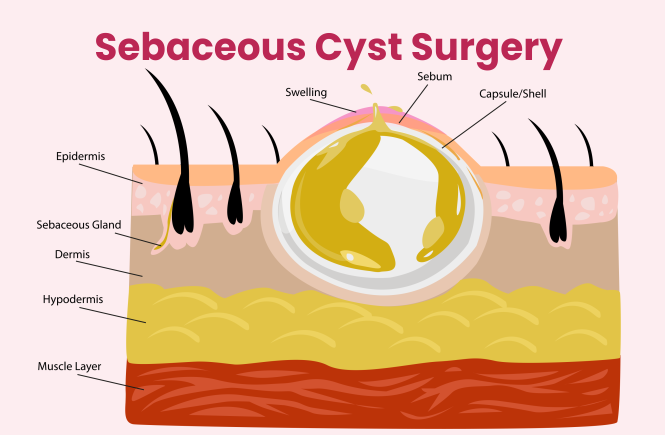BOURSESSENEGAL – Sebaceous cyst are common skin growths that can occur anywhere on the body. These benign lumps often raise concerns for many individuals due to their appearance and the discomfort they may cause. In this blog post, we’ll explore the causes, symptoms, and effective treatment options for sebaceous cyst, offering you comprehensive insights that can help manage this condition effectively.
What Are Sebaceous Cyst?
Definition and Characteristics
Sebaceous cyst, also known as epidermoid cysts, are non-cancerous lumps filled with a protein called keratin. These cysts form when the sebaceous glands, which produce oil to lubricate the skin and hair, become blocked. This blockage can happen due to various reasons, leading to a buildup of sebum (oil) and keratin within the cyst.
Common Locations
You can find sebaceous cyst on the face, neck, scalp, and back, although they can appear anywhere on the body. They often have a small, round shape and can range in size from a pea to several centimeters in diameter. While they are usually painless, some individuals may experience discomfort if the cyst becomes inflamed or infected.
Causes of Sebaceous Cyst
Blocked Sebaceous Glands
One of the primary causes of sebaceous cysts is the blockage of sebaceous glands. When these glands become clogged due to dead skin cells or other debris, the oil produced by the gland can’t escape, leading to cyst formation. This blockage can occur for several reasons, including:
- Hormonal changes: Fluctuations in hormones, especially during puberty, can increase oil production and lead to clogged glands.
- Genetic predisposition: Some individuals may be genetically more prone to developing these cysts.
- Skin trauma: Injuries, such as cuts or surgical scars, can also trigger cyst formation.
Other Contributing Factors
While blocked glands are a common cause, other factors can contribute to the development of sebaceous cysts. These include:
- Certain skin conditions: Conditions like acne can lead to cyst formation due to the overproduction of sebum and skin cell turnover.
- Poor hygiene: Although sebaceous cysts can occur in individuals with good hygiene, lack of proper skin care can exacerbate the situation.
Symptoms of Sebaceous Cysts
Identifying a Sebaceous Cyst
Sebaceous cysts often present with distinct symptoms that make them recognizable. These symptoms include:
- A small, round bump: The cyst usually feels firm or soft to the touch.
- Skin color: The cyst may appear white, yellow, or skin-colored, depending on the individual.
- Possible redness or swelling: If the cyst becomes infected, it can become red, swollen, and tender.
When to Seek Medical Attention
While most sebaceous cysts are harmless, certain symptoms may warrant medical evaluation. You should consider seeking medical advice if you notice:
- Rapid growth of the cyst
- Increased pain or tenderness
- Signs of infection: such as warmth, redness, or pus drainage
- Cysts that interfere with movement or function
Treatment Options for Sebaceous Cysts
Self-Care and Home Remedies
In many cases, sebaceous cysts do not require treatment, especially if they are not causing any symptoms. However, some home remedies can help manage discomfort or reduce the appearance of the cyst:
- Warm compresses: Applying a warm compress to the area can help reduce swelling and promote drainage.
- Tea tree oil: Known for its antibacterial properties, tea tree oil may help soothe inflammation.
- Avoid squeezing: While it may be tempting to pop the cyst, doing so can lead to infection or scarring.
Medical Treatments
If self-care measures do not alleviate the issue, several medical treatment options are available:
Surgical Removal
For cysts that are bothersome or recurrent, a healthcare provider may recommend surgical removal. This procedure typically involves:
- Local anesthesia: To minimize discomfort during the procedure.
- Excision of the cyst: The doctor will carefully remove the cyst and its sac to prevent recurrence.
Drainage
In some cases, especially if the cyst is infected, a doctor may perform drainage. This procedure involves:
- Incising the cyst: To allow the contents to escape.
- Cleaning the area: To prevent further infection.
Post-Treatment Care
After treatment, it’s essential to follow your healthcare provider’s instructions for post-operative care. This may include:
- Keeping the area clean and dry
- Avoiding strenuous activities: To minimize strain on the affected area.
- Monitoring for signs of infection: Such as increased redness or swelling.
Preventing Sebaceous Cyst
Tips for Prevention
While it may not be possible to prevent sebaceous cyst entirely, certain lifestyle changes can reduce your risk:
- Maintain good hygiene: Regularly cleansing your skin can help prevent blockages.
- Moisturize: Using appropriate moisturizers can help maintain skin health.
- Avoid picking at skin lesions: This can lead to irritation and cyst formation.
Regular Skin Check-Ups
Regular visits to a dermatologist can help you monitor your skin health. A dermatologist can provide tailored advice on maintaining healthy skin and addressing any concerns before they develop into more significant issues.
Conclusion
Sebaceous cyst may be common, but understanding their causes, symptoms, and treatment options can empower you to take control of your skin health. If you notice a lump or experience any concerning symptoms, don’t hesitate to seek medical advice. With proper care, you can effectively manage sebaceous cyst and maintain your skin’s health. Remember, taking proactive steps in your skincare routine can make a significant difference in preventing future occurrences.
By staying informed and seeking help when needed, you can navigate the challenges posed by sebaceous cyst and keep your skin looking and feeling its best.
REFERENCE : https://www.health.com/



